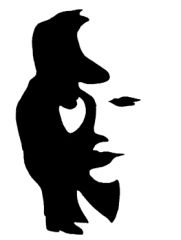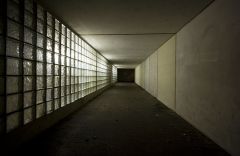![]()
![]()
![]()
Use LEFT and RIGHT arrow keys to navigate between flashcards;
Use UP and DOWN arrow keys to flip the card;
H to show hint;
A reads text to speech;
69 Cards in this Set
- Front
- Back
- 3rd side (hint)
|
Sensation
|
Process by which our sensory receptors and nervous system receive and represent stimulus energies from our environment
|
|
|
|
Perception
|
Interpreting the sensory stimulus and organizing it to make sense of things around us
|
|
|
|
Bottom-Up Processing
|
Analysis that begins with the sensory receptors and works up to the brain's integration of sensory information
|
|
|
|
Top-Down Processing
|
Information processing guided by higher-level mental processes, as when we construct perceptions drawing on our experience and expectation
|
|
|
|
Psychophysics
|
Study of relationships between the physical characteristics of stimuli, such as their intensity, and our psychological experience of them.
|
|
|
|
Absolute Threshold
|
The minimum stimulation needed to detect a particular stimulus 50% of the time
|
|
|
|
Signal Detection Theory
|
A theory predicting how and when we detect the presence of a faint stimulus (signal) amid background stimulation (noise). Assumes there is no single absolute threshold and that detection depends partly on a person's experience expectations, motivations, and levels of fatigue.
|
|
|
|
Subliminal
|
Below one's absolute threshold for conscious awareness
|
|
|
|
Priming
|
The activation, often unconsciously, of certain associations, thus predisposing one's perception, memory, or response
|
|
|
|
Difference Threshold
|
The minimum difference between two stimuli required for detection 50% of the time. We experience the difference threshold as a just noticeable difference (jnd)
|
|
|
|
Weber's Law
|
The principle that, to be perceived as different, two stimuli must differ by a constant minimum percentage (rather than a constant amount.)
|
|
|
|
Sensory Adaptation
|
Diminished sensitivity as a consequence of constant stimulation
|
Wearing a shirt and feeling it. Then a few seconds later, not feeling it consciously
|
|
|
Transduction
|
Conversion of one form of energy into another. IN sensation, the transforming of stimulus energies, such as sights, sounds, and smells, into neural impulses our brains can interpret
|
|
|
|
The product of short wavelengths
|
High Frequency - Bluish Colors
|
|
|
|
The Product of long wavelengths
|
Low Frequency - Reddish Colors
|
|
|
|
The product of large amplitude wavelengths
|
Bright Colors
|
|
|
|
The product of small amplitudes wavelengths
|
Dull Colors
|
|
|
|
Wavelength
|
The distance from the peak of one light or sound wave to the peak of the next. Electromagnetic wavelengths vary from the short blips of cosmic rays to the long pulses of radio transmission
|
|
|
|
Hue
|
Dimensions of color that is determined by the wavelength of light; what we know as the color names blue, green, and so forth
|
|
|
|
Intensity
|
The amount of energy in a light or sound wave, which we perceive as brightness or loudness, as determined by the wave's amplitude
|
|
|
|
Pupil
|
The adjustable opening in the center of the eye through which light enters
|
|
|
|
Iris
|
A ring of muscle tissue that forms the colored portion of the eye around the pupil and controls the size of the pupil opening (Pg. 237)
|
|
|
|
Lens
|
The transparent structure behind the pupil that changes shape to help focus images on the retina
|
|
|
|
Retina
|
The light-sensitive inner surface of the eye, containing the receptor rods and cones plus layers of neurons that begin the processing of visual information
|
|
|
|
Accomodation
|
the process by which the eye's lens changes shape to focus near or far objects on the retina
|
Concerning eyes
|
|
|
Rods
|
Retinal receptors that detect black, white, and gray; necessary for peripheral and twilight vision, when cones don't respond
|
Retinal Receptors
|
|
|
cones
|
Retinal receptors cells that are concentrated near the center of the retina and that function in daylight or in well-lit conditions. The cones detect fine detail and give rise to color sensation
|
Retinal Receptors
|
|
|
Optic Nerve
|
The nerve that carries neural impulses from the eye to the brain
|
|
|
|
Blind Spot
|
the point at which the optic nerve leaves the eye, creating a blind spot because no receptor cells are located there
|
|
|
|
Fovea
|
The central focal point in the retina, around which the eye's cones cluster.
|
|
|
|
What is the pathway of neural impulse from eyes to visual cortex
|
Ganglion Axons -> Optic Nerve -> Visual Area of Thalamus -> Visual Cortex(pg. 241)
|
|
|
|
Feature Detectors
|
Nerve cells in the brain that respond to specific features of the stimulus, such as shape, angle, or movement
|
|
|
|
Parallel Processing
|
The processing of many aspects of a problem simultaneously; the brain's natural mode of information processing for many functions, including vision. Contrast with the step-by-step (serial) processing of most computers and of conscious problem solving
|
|
|
|
Young Helmholtz trichromatic (three-color) Theory
|
The theory that the retina contains three different color receptors - one most sensitive to red, one to green, one to blue - which, when stimulated in combination, can produce the perception of any color
|
|
|
|
Opponent-Processing Theory
|
The theory that opposing retinal processes (red-green, yellow-blue, white-black) enable color vision. For example, some cells are stimulated by green and inhibited by red; others are stimulated by red and inhibited by green
|
|
|
|
Audition
|
The sense or act of hearing
|
|
|
|
Frequency (ear)
|
The number of complete wavelengths that pass a point in a given time
|
|
|
|
Pitch (ear)
|
A tone's experienced highness or lowness; depends on frequency.
|
|
|
|
Middle Ear (ear)
|
The chamber between the eardrum and cochlea containing three tiny bones (hammer, anvil, and stirrup)that concentrate the vibrations of the eardrum on the cochlea's oval window.
|
|
|
|
Cochlea
|
A coiled, bony fluid-filled tube in the inner ear through which sound waves trigger nerve impulses
|
I
|
|
|
Inner Ear
|
the innermost part of the ear, containing the cochlea, semicircular canals, and vestibular sacs
|
|
|
|
Place Theory
|
IN hearing, the theory that links the pitch we hear with the place where the cochlea's membrane is stimulated
|
|
|
|
Frequency Theory
|
In hearing, the theory that hte rate of nerve impulses travelling up the auditory nerve matches frequency of a tone, thus enabling us to sense its pitch
|
|
|
|
Conduction Hearing Loss
|
hearing loss caused by damage to the mechanical system that conducts sound waves to the cochlea
|
|
|
|
Sensorineural hearing loss
|
hearing loss caused by damage to the cochlea's receptor cells or to the auditory nerves; also called nerve deafness
|
|
|
|
Cochlear implant
|
a device for converting sounds into electrical signals and stimulating the auditory nerve through electrodes threaded into the cochlea
|
|
|
|
Kinesthesis
|
The system for sensing the position and movement of individual body parts
|
|
|
|
Vestibular Sense
|
the sense of body movement and position, including the sense of balance
|
|
|
|
Gate-Control Theory
|
The theory that the spinal cord contains a neurological "gate" that blocks pain signals or allows them to pass on to the brain. The "gate" is opened by the activity of pain signals traveling up small nerve fibers and is closed by activity in larger fibers or by information coming from the brain
|
|
|
|
Sensory interaction
|
The principle that one sense may influence another, as when the smell of food influences its taste
|
|
|
|
Gestalt
|
An organized whole. Gestalt psychologists emphasized our tendency to integrate pieces of information into meaningful wholes
|
|
|

Figure-Ground
|
The organization of the visual field into objects (the figures) that stand out from their surroundings (the ground)
|
|
|
|
Grouping
|
The perceptual tendency to organize stimuli into coherent groups
|
|
|
|
Types of Grouping that we do
|
Proximity: How close similar objects are to each other
Similarity: Grouping of similar objects in a group of 2 or more different objects Continuity: The continuous pattern that we follow Connectedness: The way we perceive objects that are connected somehow (like a line) |
|
|
|
Depth Perception
|
The ability to see objects in three dimensions although the images that strike the retina are two-dimensional; allows us to judge distance
|
|
|
|
Visual Cliff
|
A Laboratory device for testing depth perception in infants and young animals
|
|
|
|
Binocular Cues
|
Depth cues, such as retinal disparity, that depend on the use of two eyes
|
|
|
|
Retinal Disparity
|
A binocular cue for perceiving depth : by comparing images from the retinas in the two eyes, the brain computes distance - the greater the disparity (difference) between the two images, the closer the object
|
|
|
|
Monocular Cues
|
Depth cues, such as interposition and linear perspective available to either eye alone
|
|
|
|
Linear Perspective
|
Lines seem to converge at one point where it is on a horizon line
|

|
|
|
Horizontal-vertical illusion
|
tendency for observers to overestimate the length of a vertical line relative to a horizontal line of the same length.[1] This involves a bisecting component that causes the bisecting line to appear longer than the line that is bisected.
|

|
|
|
Phi Phenomenon
|
An illusion of movement created when two or more adjacent light blink on and off in quick succession
|
|
|
|
Perceptual Constancy
|
Perceiving objects as unchanging (having consistent shapes, size, lightness, and color) even as illumination and retinal images change
|
|
|
|
Color Constancy
|
Perceiving familiar objects as having consistent color, even if changing illumination alters the wavelengths reflected by the object.
|
|
|
|
Perceptual Adaptation
|
IN vision, the ability to adjust to an artificially displaced or even inverted visual field
|
|
|
|
Perceptual Set
|
A mental predisposition to perceive one thing and not another
|
|
|
|
Human Factors Psychology
|
A branch of psychology that explore how people and machines interact and how machines and physical environments can be made safe and easy to use
|
|
|
|
Extrasensory perception (ESP)
|
The controversial claim that perception can occur apart from sensory input; includes telepathy, clairvoyance, and precognition
|
|
|
|
Parapsychology
|
The study of paranormal phenomena, including ESP and psychokinesis
|
|

